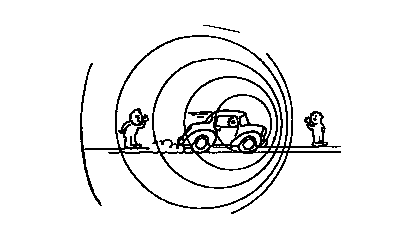Sonar
The best way for submarines to find out about what's
around them is to use sonar. Light does not penetrate very far into
water, so video cameras are not very effective below certain depths. So
submarines use sonar, an acronym for sound navigation and ranging. There
are two types of sonar used by submarines, active and passive. Active
sonar is a system in which a sound wave is emitted and then reflects off other
objects and bounces back. The sound wave is then recorded and by noting
the time it takes from emission to when it comes back, you can tell how far
away an object is. You can also tell a lot of other things about the
object, such as speed, but these things will be discussed later. The
second type of sonar is passive sonar. Passive sonar is simply using
very sensitive underwater microphones to detect noises around you. Passive
sonar is used most often because active sonar can be detected by other vessels.
The computer console records the sound from the passive sonar and compares
it to a library of sound signatures to try and find a match. That way
the target can be identified and the ship knows whether it is a threat or
not. This way the submarine can distinguish the sounds of motors or
other boats from the natural sounds in the ocean. Here is an example
of a sonar console on a submarine:

Image courtesy of: The
National Museum of American History
As I mentioned earlier, a submarine can use active
sonar to tell the speed of another vessel in the water. It does this
using the doppler effect. You have probably noticed that as an ambulance
or police car drives past you with its siren on, the pitch changes. This
is due to the doppler effect. The pitch of the siren is higher as it
moves toward you and lower as it passes and moves away from you. This
is because the crests of the sound wave are closer together as it moves toward
you and farther away as it moves away from you. Here is a simple illustration
of this effect:

Image courtesy of: Doppler Effect
This is important for submarines, because if they emit
a wave of a known frequency, and it bounces back with a different frequency
they can calculate the speed of that object. This is possible because
the wave's frequency is shifted by a certain amount depending on the speed
of the object. So if you take into account the original frequency, the
submarine's speed, and the speed of sound in water you can calculate the
target's speed by this equation: f'=(v + vo/v - vs)f,
where f is the original frequency, f' is the reflected frequency, v is the
speed of sound in water, vo is the speed of the submarine, and
vs is the speed of the target. This equation assumes that
the target is moving directly toward the submarine, and if that is not the
case it becomes slightly more complicated but the concept is still the same.
This form of the equation refers to the target's motion being toward
that of the submarine. For the case of motion away from each other,
the signs are simply switched from +/- to -/+.
The range of the target can be computed as well by using a simple distance is equal to rate multiplied by time equation. By knowing the speed of sound and timing how long it takes from the time the sound wave was emitted to the time it gets back, you can find the range of the target.
The range of the target can be computed as well by using a simple distance is equal to rate multiplied by time equation. By knowing the speed of sound and timing how long it takes from the time the sound wave was emitted to the time it gets back, you can find the range of the target.